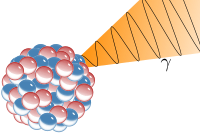
Photo from wikipedia
Cyclotron radiation emission spectroscopy (CRES) is an approach to measuring the energy of an electron trapped in an externally applied magnetic field. The bare electron can come from different interactions,… Click to show full abstract
Cyclotron radiation emission spectroscopy (CRES) is an approach to measuring the energy of an electron trapped in an externally applied magnetic field. The bare electron can come from different interactions, including photoelectric absorption, Compton scatters, beta decay, and pair production. CRES relies on measuring the frequency of the electron’s cyclotron motion, and because the measurement times extend over 106–107 cycles, the energy resolution is on the order of a single electronvolt. To date, CRES has only been performed on internal beta-emitting radioisotopes, but the technology can be applied to x-ray spectrometery through appropriate selection of a target gas and sufficient intensity of the distinct x-ray source. The applications of this technology range from high-precision measurements of atomic energy levels to calibrations of basic science experiments, to trace element identification. In this work we explore the use of CRES for x-ray spectroscopy within the rubric of measuring the energy levels of argon. Though the energy levels of argon are well established, we adopt this motivation as an example question around which a detector may be designed. The issues we explore include target material, density, electron trapping depth, noise levels, and overall efficiency. We also discuss spectral deconvolution and how the multiple peaks obtained from a single target/source pair can be used to enhance the robustness of the measurement.
Journal Title: New Journal of Physics
Year Published: 2019
Link to full text (if available)
Share on Social Media: Sign Up to like & get
recommendations!